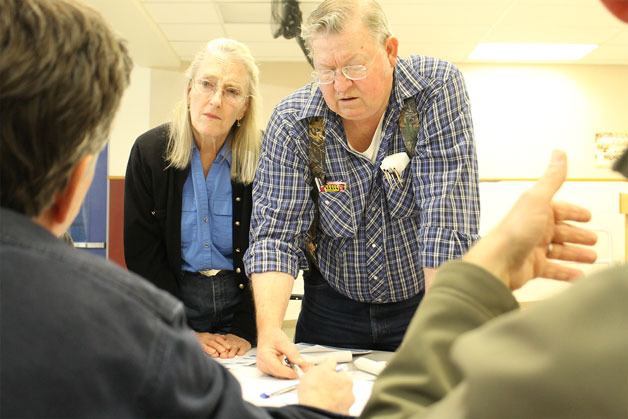Proposed changes for growth in Langley spurred confusion and discussion at Island County Planning Department’s public meeting Monday night.
Over 40 people attended a county public input meeting on the comprehensive plan update and how it may change the urban growth area (UGA) of Langley, as well as land surrounding the UGA which is designated as a joint planning area (JPA). The proposed changes will reshape Langley’s growth area and help guide growth and development over the next two decades.
Though the changes are years down the road, Keith Higman, Island County’s interim director of long-range planning, said some attendees were mistaken on when the proposed changes will be implemented.
They were also confused by the terminology, zoning proposals and criteria that were used to reach the proposals. Higman said attendees’ concerns may have been a result of jumping to conclusions based on loose assumptions.
“The topic of conversation is really complex and complicated,” said Higman, in an interview after the meeting. “I think attendees were already trying to derive information from maps before information was presented to them and what it actually meant.”
“If you’re not in the UGA or in the city, we’re talking way down the road. Maybe it would take a little bit of the stress away because some people were a little loaded with stress this evening,” he added.
Under the proposed changes, as was recommended by the city after a series of public meetings, Langley’s urban growth area will be reduced to just about current city limits. Four properties along Coles Road will also be included due to the city’s sewer line running through them. The land in the existing urban growth area, which stretches beyond city limits, will become a joint planning area and allows for potential growth in Langley if population projections are surpassed in the future. Buildable land analysis projections show Langley’s current urban growth area as being oversized and in need of reduction. The results project an excess of 859 homes by 2036. These growth areas must be large enough to accommodate projected population and employment growth over the next 20 years, but no bigger than necessary.
Langley resident Tiny Tillman, who has diligently attended meetings on the matter, felt the evening was an educational platform if nothing else.
“It’s very confusing, all this,” Tillman said. “For the people that work on it everyday, they’re used to these terms. There’s a lot of educating for the public so they have an understanding of all this.”
Tillman was in favor of the county’s proposed changes, adding that she was in attendance in order to ensure she has flexibility and control of her property.
Senior Long Range Planner Beckye Frey led the presentation portion of the meeting, which provided information on analysis results, proposed zoning changes, review of JPA options and proposals and preliminary maps. The county’s planning department also answered questions while stationed at different topic areas around the room.
Frey said the confusion was in part due to the content being new. The planners tried to present the information in small, digestible pieces by providing fact sheets and step-by-step walkthroughs on how criteria for zoning plans were reached.
“It is complicated, it is new, so we’re trying to make it so they can take little bits at a time,” Frey said.
Attendees were later split into groups and provided maps of the zoning changes. They were allowed to draw in where they felt zoning should be redirected, by using colored markers, followed by presentations to the audience on how they determined their choices.
Higman said one group was focused on its own community and the vision they had for its future. Other groups, however, were more interested in what the future of the city looked like. Higman said it’s ultimately the planning department’s job to make recommendations to the planning commission, who will then make recommendations to the board.
“The hard policy decisions here are about upsetting the fewest number of people because there are no decisions that are going to make everyone happy and finding that middle ground where there’s as many people supporting a move in a certain direction as we can,” Higman said.



